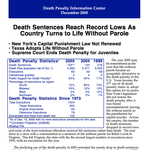The Death Penalty in 2005: Year End Report
Posted on Dec 15, 2005

OVERVIEW Top
The year 2005 may be remembered as the year that life without parole became an acceptable alternative to the death penalty in the U.S. Texas became the 37th out of 38 death penalty states to adopt this option for its juries. New York’s legislature did not restore the death penalty after it was found unconstitutional, leaving life without parole as the punishment for capital murder. Across the country, the number of death sentences dropped to record lows and some of the most notorious offenders received life sentences rather than death. The year drew to a close with a commutation to a sentence of life without parole for Robin Lovitt in Virginia. This left Virginia, the state with the second largest number of executions since 1976, with no executions for the year.
The declining use of the death penalty in 2005 extended the steady drop in death sentences and in the size of the death row in recent years. Although executions increased by one in 2005, they are still 39% below their peak in 1999.
Death sentences averaged about 300 per year nationally during the late 1990s. Since then, the number of death sentences per year has dropped 55%, to 125 in 2004. The projection for 2005 is 96 death sentences (based on data from 3/4 of the year) (Correction: the number of death sentences for 2005 should be estimated at 125, the same as for 2004) — the lowest number since the death penalty was reinstated in 1976. In Harris County, Texas, often referred to as the “capital of capital punishment,” there were only 2 death sentences in all of 2005.
Instead of the death penalty, juries, legislators, prosecutors, and victim family members increasingly expressed their preference for life-without-parole sentences, which carry much less uncertainty than death sentences. According to a study by the New York Times, the number of prisoners serving life sentences has doubled in the past decade.
Edna Weaver, whose daughter was murdered in New Jersey, expressed relief that the defendant was spared the death penalty: “I’m so thankful it came out the way it did.… I wouldn’t want another mother to feel like I do – it’s a feeling I could never put into words.”
Similarly, the family of Louisiana murder victim Kim Groves asked the federal government to forgo seeking the death penalty for co-defendants Paul Hardy and Len Davis: “Executing these two men will not bring Kim Groves back to life.… The family believes the death penalty would in fact be the lesser of the punishments and that the finality and duration of a life sentence would be much more difficult and severe to Mr. Davis, in particular, than death.”
Even in notorious cases, such as that of Eric Rudolph, who killed two people at a medical clinic and set off a bomb at the Olympics in Atlanta, federal prosecutors accepted a guilty plea and a sentence of life-without-parole. In Kansas, Dennis Rader, who murdered 10 people, was given multiple life sentences. Similarly, in recent years serial killers such as Gary Ridgway in Washington, who confessed to 48 murders, and Charles Cullen, a nurse who killed 17 people in New Jersey and Pennsylvania, were given life without parole sentences.
PRESS RELEASE Top
Read the press release here.